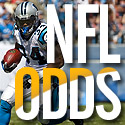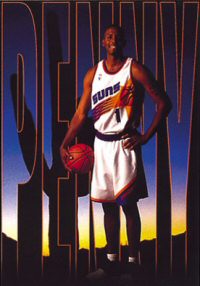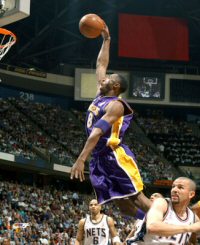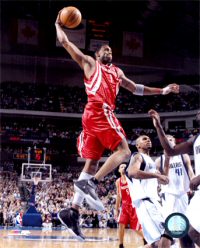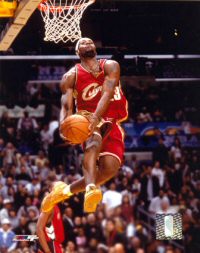The "Next Jordan"
NBA Home / Sports Channel / Bullz-Eye Home
When Michael Jordan reached the back half of his career, the search began for the “Next Jordan.” The press started all the “Next Jordan” talk, but it was fueled by an NBA fan base determined to anoint the next great superstar. The criteria? Simple: 1.) he had to play shooting guard or small forward, and 2.) he had to be able to jump out of the gym. Expectations were raised and rarely met and, as a result, more than a few careers are unfairly considered utter disappointments.
As a benchmark, here’s a quick look at Jordan’s 15-year career:
Career stats:
30.1 ppg, 6.2 rpg, 5.3 apg, 2.4 spg, .8 bpg, .497 FG%, .327 3P%, .835 FT%
Six-time NBA champion (1991-93, 1996-98)
Five-time MVP (1988, '91, '92, '96, '98)
10-time All-NBA First Team (1987-93, 1996-98)
All-NBA Second Team (1985)
Defensive Player of the Year (1988)
Nine-time All-Defensive First Team (1988-93, 1996-98)
Rookie of the Year (1985)
14-time All-Star; All-Star MVP (1988, '96, '98)
Keep in mind that Jordan retired twice (10/6/93; activated from retirement, 3/18/95; retired again, 1/13/99; signed with Washington Wizards, 9/25/01), so had he played the '93-94 and '94-95 seasons, his numbers would be even better.
Now let’s look at eight guys who were saddled with the “Next Jordan” label and see how their careers have progressed with that giant albatross hanging around their necks. They are listed chronologically and are ranked on a scale of 1 (Harold Miner) to 23 (His Airness).
Visit The Scores Report, the National Sports Blog, to post your thoughts or suggestions!
Harold Miner
Jordan stats: 30.1 ppg, 6.2 rpg, 5.3 apg, 2.4 spg, 0.8 bpg, .497 FG%, .327 3P%, .835 FT%
Miner (aka “Baby Jordan”) was the first guy that I remember getting this type of hype, and he didn’t fail to disappoint. He played in Miami for three years after getting drafted #12 overall by the Heat in 1992, and he also had a 19-game stint with the Cleveland Cavaliers before getting bounced out of the league. A two-time NBA Slam Dunk contest champ, we soon learned that the only thing Baby Jordan could do was dunk. In fairness, he only played 18.7 minutes per game, so he didn’t get the playing time that Jordan did, but that no doubt had something to do with Miner’s talent, or lack thereof. Last I heard, he was living in seclusion in the Las Vegas desert. Ouch.

Penny Hardaway
Jordan stats: 30.1 ppg, 6.2 rpg, 5.3 apg, 2.4 spg, 0.8 bpg, .497 FG%, .327 3P%, .835 FT%
Hardaway was chosen third overall in the 1993 draft by the Golden State Warriors, but was immediately traded to the Orlando Magic for Chris Webber. He was fortunate enough to play with Shaquille O’Neal for three years and the duo led the Magic to a Finals appearance in 1995, but they couldn’t contend with Hakeem Olajuwon, who was playing at the very top of his game, and the Houston Rockets. Orlando turned out to be too small for both Penny and Shaq so the big man bolted for LA, and the season after Shaq left was the last time Penny averaged better than 20 ppg. Since then, he’s been an injury-riddled complimentary player, playing for Phoenix and now New York. Once he reached the midpoint of his career, Hardaway had lost most of the athleticism that initially drew the MJ comparisons, though he was never really on track to match any of Jordan’s accomplishments anyway. Aside from that, Hardaway should be docked another point just for having a first name like Anfernee.

Grant Hill
Jordan stats: 30.1 ppg, 6.2 rpg, 5.3 apg, 2.4 spg, 0.8 bpg, .497 FG%, .327 3P%, .835 FT%
Hill was the third overall pick in the 1994 draft and averaged 20+ ppg for six consecutive seasons with Detroit before being traded to Orlando. He was never the scorer that Jordan was, but his career rebound and assist numbers exceed MJ’s and he’s always been an underrated midrange shooter. Hill was always humble when people compared him to Jordan and usually deflected such talk. In fact, when asked about the comparison a few years ago, he said, "Whether you're Vince Carter, Jerry Stackhouse, Allen Iverson or Tracy McGrady, all you can do is try to be the best player you can be and not really think about it. It's more a fascination of the media. And barber shops." One mark against him is that he’s only played in 15 career playoff games. Hill earns a 13 since he’s been so unlucky with all the health problems. It’s a shame – before his first major injury, he was one of the most versatile and exciting players the league had seen in recent years.

Jerry Stackhouse
Jordan stats: 30.1 ppg, 6.2 rpg, 5.3 apg, 2.4 spg, 0.8 bpg, .497 FG%, .327 3P%, .835 FT%
Like Hardaway and Hill, Stackhouse was drafted third overall (in 1995) and was the first Tar Heel dubbed “The Next Jordan.” Sure, Stack can get you 20 points, but with that shooting percentage, he’s going to have to take a ton of shots to do it. That’s the biggest difference between Stackhouse and Jordan – just look at MJ’s shooting percentage: it’s phenomenal for a guard, especially in today’s NBA. Stack has bounced around the league a bit, with stints in Philadelphia, Detroit and Washington before finally landing in Dallas. He’s been a solid pro, but hasn’t been an impact player for several years. Making matters worse, he’s only played in 31 playoff games in 11 seasons.

Kobe Bryant
Jordan stats: 30.1 ppg, 6.2 rpg, 5.3 apg, 2.4 spg, 0.8 bpg, .497 FG%, .327 3P%, .835 FT%
Curiously named after a variety of steak, Kobe Bryant was selected #13 overall in 1996 by the Charlotte Hornets and was promptly dealt to the Lakers for Vlade Divac. The trade seemed even at the time, because Bryant was a relatively unknown high schooler and Divac was in the prime of his career, but it turned out to be a boon for the Lakers, who got one of the most physically gifted shooting guards of the modern era (and signed Shaq one week later). It’s true – Bryant is Jordan-esque at times, throwing down monster dunks on guys and hitting incredibly acrobatic shots. However, his career shooting percentage is a bit misleading since he’s checked in at under .440 the last two seasons. He also tends to hog the ball (something Jordan did at times, but as mentioned above, MJ shot at a much better clip) and mistakenly thinks he can score in any situation. Kobe’s won three NBA Championships, but his legacy will never match Jordan’s because he had O’Neal anchoring the middle during those years. Bryant said he doesn’t want to be compared to MJ, which is good because, unless he drastically changes his game and becomes a more efficient player, he’ll never live up to His Airness. Plus, I can’t see MJ running Phil Jackson and the best center in the league out of town, just so he can go it alone. Not smart.

Tracy McGrady
Jordan stats: 30.1 ppg, 6.2 rpg, 5.3 apg, 2.4 spg, 0.8 bpg, .497 FG%, .327 3P%, .835 FT%
McGrady’s stats are eerily similar to Bryant’s, only he hasn’t had the luxury of playing with Shaq for most of his career. Like Bryant, T-Mac came to the NBA directly from high school and, in 1997, the Toronto Raptors selected him ninth overall (my beloved Bucks selected Danny Fortson #10 – ugh). When the Raptors drafted Vince Carter a year later, it was clear McGrady’s days in Toronto were numbered and he was shipped off to Orlando. After four productive yet tumultuous seasons with the Magic, McGrady was traded to Houston for Steve Francis and Cuttino Mobley. These days, it looks like T-Mac’s found a permanent home and, if Yao Ming continues to develop, the duo could be in store for a few NBA Finals appearances. McGrady is sometimes unstoppable offensively, but the knock against him is that he doesn’t put forth maximum effort on defense. However, in last year’s playoffs, he was assigned to cover Dirk Nowitzki and successfully took the big German out of his game. Considering MJ was named to the All-Defensive First Team nine times and earned Defensive POY honors once, McGrady is going to have to improve this part of his game if he’s ever going to approach Jordan’s legacy.

Vince Carter
Jordan stats: 30.1 ppg, 6.2 rpg, 5.3 apg, 2.4 spg, 0.8 bpg, .497 FG%, .327 3P%, .835 FT%
Like McGrady, Carter had the misfortune of being drafted (in 1998) by one of the worst run franchises in the league, the Toronto Raptors. Following a series of up and down seasons (mostly down), VC’s embarrassing lack of effort at the start of his seventh season forced the Raptors to grant Carter’s wish by trading him to the Nets for Alonzo Mourning, Eric Williams, Aaron Williams and two first-round draft picks. Following the deal, Carter was Jordan-esque in New Jersey, averaging 28 points, six rebounds and five assists per game while throwing down some vintage Vinsanity dunks. He’s far and away the best three-point shooter on this list and cashed in on 42.5% of his long-range attempts in 57 games with the Nets last season. And, like Jordan, Carter’s greatest attribute continues to be his unreal athleticism, skills that help him stuff the stat sheet each and every night. Being a fellow Tar Heel, the Jordan comparisons will never end, much to Carter’s chagrin. He bristles at the comparison and never said a word to MJ when the two faced each other.

LeBron James
Jordan stats: 30.1 ppg, 6.2 rpg, 5.3 apg, 2.4 spg, 0.8 bpg, .497 FG%, .327 3P%, .835 FT%
After Carter, the “Next Jordan” talk died down for a while when the press and fans alike realized there may never be another MJ. But then a kid from Akron St. Vincent-St. Mary High School caught the basketball world’s eye and, after entering the league as the top pick in 2003, LeBron James reignited the “Next Jordan” debate. Based on his first two seasons, James has the best chance of any guy on this list to match or exceed Jordan’s success. In just his second season, LeBron averaged 27 points, 7 rebounds and 7 assists, something MJ only did once (in 1988-89 season, when he averaged 32 points, 8 boards and 8 dimes). King James is also the only guy on the list that approaches MJ’s average in thefts per game, but he still must improve his defense if he hopes to reach 2.4 steals a night. Of course, the main reason Jordan had such a phenomenal career was because each offseason, he would set out to improve upon a particular part of his game. One year it was his three-point shot, the next it was his post-up game, the next, defense. For James to surpass MJ as the greatest player of all time, he’ll have to develop the kind of tireless work ethic that turned Michael Jordan into Air Jordan. Considering LeBron wore #23 in high school and wears the same number in the pros, it's clear he's not shying away from the MJ comparisons. If he continues working hard to reach his full potential (and chooses the right franchise when his contract is up), all of the accolades and achievements will come naturally.

In the end, all this “Next Jordan” talk is really just a conversation about who will be the next great superstar. There will never be another Michael Jordan. Whoever has the skill and fortune to approach his legacy will simultaneously be building one of his own. This “best player” mantle is up for grabs, but the three guys that have a legitimate shot are Kobe Bryant, Tracy McGrady and LeBron James. If Kobe were to lead the Lakers to two or three more championships, you could make a strong argument for him. If McGrady and Yao start a dynasty and win four or five titles over the next several years, then you’d have to give the nod to T-Mac. But the guy with the most upside is LeBron – however, his situation is also the most tumultuous. His contract is up after the 2006-07 season and, just like that old Clash song, “Should I Stay or Should I Go,” he has to decide if the Cavs are poised for a series of title runs or if he needs to change teams to get his shot at a championship.

